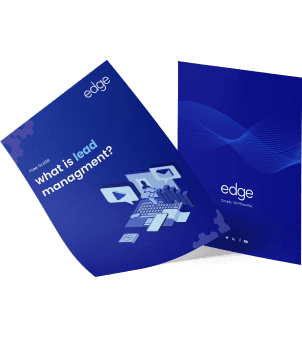In any business, lead nurturing plays an essential part. A successful lead nurturing program focuses the marketing and communication efforts on listening to the clients’ needs and providing them with information and answers that are needed to build trust, increase brand awareness, and maintain a relationship until they are ready to make a purchase of your product/service. According to Marketo, on average, half of the leads haven’t made their decision on whether to buy or not, and MarketingSherpa reports that almost 80% of new leads never end up making a purchase at all.
It’s highly unrealistic to think that you can find a lead and immediately pitch them and close the deal. Leads are just possibilities. They’re not a guaranteed sell. This is where lead nurturing comes into effect.
You may get a lead from various platforms. Either you got the lead through an online opt-in form in exchange for a lead magnet or you’re working your way through a cold call or cold email process. Maybe it was a business card given to your sales team at any show/ event. The possibilities are numerous.
Did you know lead nurturing leads to 47% larger purchases than leads that were not nurtured will buy? This is why lead nurturing is so important to include within your sales and marketing strategy. The time and effort it takes to nurture your leads is nothing compared to the ROI it will yield. It’s definitely worth your investment and a system you can bank on.
Components of lead nurturing
The lead nurturing program consists of a cross-channel system that combines content marketing and marketing automation efforts to create a system that builds and maintains relationships with the customers. Here are some of the basic components for lead nurturing:
- Multichannel distribution.
In order to implement a successful lead nurturing campaign, all your channels must be connected with each other, so that you can maintain contact with leads across the board. - Web.
Your website is a great place to new email addresses from visitors, but it’s also a fantastic place where you can start conversations. To make the most of the web experience, it should be dynamically personalized to reinforce and extend the dialogue started in emails. - Retargeting.
Display ads and retargeting can be an important part of your marketing strategy. - Social.
Social media is a critical part of cross-channel nurturing. Running social media campaigns is great, but making every campaign social is better. When you connect your lead nurturing program to the efforts you put on social media, they enhance one another. - Direct mail.
Consider adding direct mail to your lead nurture campaigns to further personalize and add a human touch. - Lead scoring.
To develop a successful lead scoring strategy, sales and marketing teams must come together to a point where a particular lead is within the brand’s buying model. This common ground is the backbone of a strong lead nurturing system. It identifies when and how to address each buyer with the most timely and relevant communications. - Content marketing.
If lead scoring is the backbone of a successful online marketing strategy, then content marketing is the muscle. Content marketing is the process of creating content that is, both, relevant and valuable. This strategy can include content in your emails, as well as on your website and your social media channels, including video, podcasts, and more.
Best practices for lead nurturing
Lead nurturing is like trying to have a perfect relationship with your dream partner. But as is the case, not every lead can be retained. Here are 5 best practices everyone must follow to nurture their lead:
- Personalize:
Your lead nurturing email campaign should have a personal touch. You may be using automated emails, but it shouldn’t look automated or spammy. Avoid sending the same emails to all of your leads. This would mean danger for your business. Get your emails personalized. - Don’t overdo things:
Staying in touch with your prospects is important. But don’t overdo things such as flooding their inbox with emails. It is highly irritating and may become one of the major reasons for high unsubscribe rates. - Avoid sending every mail to all your leads:
You don’t have to send emails daily. It will lead your prospects to leave you and get in business with your competitor. Similarly, sending every email to every person would also result in a similar disappointment for the customer. Avoid mass messaging and stay away from the ‘’One Fits All” strategy. There are various ways to segment your leads. Try grouping contacts on the basis of personal interests, behavior, demography, or buying experience.
Steps to implement an excellent lead nurturing program
A lead nurturing program is a foundation upon which your business stands firm. It just lays the framework for what you need to convert new and returning customers. There are few other steps to implement an excellent lead nurturing program.
- Define your leads.
The lead nurturing program heavily leans on the cooperation of sales and marketing teams to work together. To define the perfect lead, you need to come up with a “joint definition” agreed upon between sales and marketing teams. You can consider some parameters such as determining your market, who is already in your database, current prospects, which buyers are closing to establish lead scoring thresholds, lead fit, and lead engagement points. - Build your lists.
To grow your business and set up a robust lead nurture program, you need to feed the top of the funnel with list-building tactics. One effective way to do this is by leveraging digital business cards like Uniqode’s business card, which allows for seamless lead capture at events, networking sessions, and meetings. Unlike traditional business cards, digital versions eliminate the risk of misplaced contacts and enable instant follow-ups, keeping lead data organized and up to date. Regularly give your leads a checkup, identify and scrub duplicates, and remove inactive or junk contacts. - Segment your audience groups.
Lead segmentation is essential to your marketing success, particularly with lead nurturing. The more you segment, the more relevant your lead nurture programs will be. If you are not relevant, your efforts pay dividends. Adding behavioral segmentation and targeting to your lead nurture campaigns increases relevance and engagement cross-channel. - Test and optimize your campaigns.
Lead nurturing must be monitored and tested regularly to maintain the program’s health and effectiveness. Without optimizing the program for your target audience, it won’t yield efforts. You need to optimize your lead nurture frequency, path, content and creativity (including copy length and design), and content mix.
How can lead nurturing help your business?
The relationship between consumers and marketing is ever-evolving. Making a purchase these days takes more time for a buyer than it has in the past, as that process now includes self-education and a need to build trust with the company they are looking to buy from.
In order to overcome these ever-changing challenges, your lead nurture program must be sophisticated, intuitive, and considerate in its courtship with the customer.
By developing a lead nurture program and implementing it with the right marketing automation process, you’ll be able to create intuitive and adaptive communication at scale. This can help you to establish and maintain a long-term relationship with your buyer, which creates consistency in buyer interest and ultimately builds loyalty and advocacy for your brand.
Apart from this, it will also allow you to measure the buyer’s interest and behavior as they interact with your brand, ensuring your future campaigns are always evolving to become more relevant, and ultimately, more profitable.
Lead Generation vs Lead Nurturing
The line between lead generation and lead nurturing is often blurred. Are they one and the same? No. These two processes are related but unique. They require different attention and marketing focus each.
What Is Lead Generation?
Lead generation is the process of generating interest in a company’s products and services via its marketing efforts. The outputs of these efforts are potential new buyers the company can pursue a business relationship with.
The Process
Lead generation is driven by integrated marketing efforts that target and engage relevant audiences to establish a relationship and bring them into the business development process. These relevant audiences comprise primary and secondary users, influencers, buyers, and decision-makers. Each one plays a role and carries weight in purchase decisions.
Marketing Efforts
Inbound marketing approaches where audience members determine when and how to engage are prevalent. Inbound marketing channels that commonly combine to generate the most leads include events (online and offline), content marketing, and social media. Creating blogs, eBooks, videos, and related content and then promoting these assets on social media is a good example of these efforts. Producing and promoting the right content at the right time for the right audiences naturally supports higher volumes of qualified leads.
What Is Lead Nurturing?
Lead nurturing is the progressive process of building a relationship with leads through different interactions over time with the goal of ultimately converting the leads into buyers. This typically does not happen overnight. It can be tempting to try and fast-track buying decisions but smart organizations understand the different aspects of the buyer journey and provide the right marketing support at each juncture.
The Process
So, how do you nurture a lead? Lead nurture activities are largely determined by where a lead is in the buyer journey. If they are in the awareness phase and downloaded gated content from your website, follow up periodically via email with relevant next-step blogs and articles they may find useful.
The key is extending opportunities for them to deepen their interest and strengthen the relationship. In the consideration stage, individuals are beginning to evaluate options for addressing their needs.
For example, a prospect is interested in purchasing a marketing automation application and your company’s offering is on their list of possible solutions. Here, a more in-depth white paper or eBook showing key considerations and capabilities is appropriate. In the decision stage, individuals look to narrow their list of possibilities down to a selection they can be confident in. Providing a case study that showcases the success of others who use your product or service or sharing product comparisons that show how your brand stands above others are recommended.
Marketing Efforts
Lead nurturing activities are commonly comprised of email marketing and related well-timed and targeted digital outreach (e.g., retargeting, social, etc.). Use these activities intelligently to keep your organization at the top of prospects’ minds. This could entail enrolling them in a drip email series of related follow-up content, sending them the organization’s e-newsletter, and showing display ads promoting your offerings as they surf the internet.
Lead Generation + Lead Nurturing = Greater Success
If a business does a great job of generating leads but does little or nothing to turn leads into buyers, they are not likely to succeed. If a business does a great job of nurturing leads but doesn’t generate a high enough quantity of leads, they are unlikely to succeed. A business needs both lead generations and lead nurturing processes to work together, fuel one another, and support sustainable business success.













